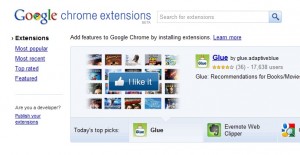Geeks old enough to remember using MS-DOS will undoubtedly remember the feeling of automating their bootup programs using a batch file. Around the same time that Bill Gates muttering that 640K ought to be enough memory for anyone, those same geeks looked at each other and begin whittling down their batch files so there was more memory. After all, Gates’ developers were working hard on Windows and the Office suite which would suck the memory out of anyone’s system. Along the way, we learned to be judicious with all of our new toys when we stretched them to the breaking point. One more phone app? Okay, okay, but that’s a pretty clunky menu.

And then Chrome, the uber-fast browser expected to be at the heart of Google’s operating system launching in 2010, went down the Firefox path and started adding extensions and themes. There are some under-the-hood differences that won’t slow down Chrome’s sleek browsing as much, but everything — even wicked cool plugins — in moderation is a good axiom.
I think I’ve installed darn near everything I could lay my hands on up until now. One reason that is so much easier is because you don’t have to reboot Chrome for changes to take effect. As of today, here are 10 Chrome Extensions I still like and have kept installed:
1. Feedly. I may have kept Firefox as active as I did simply to use this amazing UI for Google Reader. Feedly is my favorite extension.
2. Lorem Ipsum Generator. We do a lot of mockups. This easy dummy text generator ends the need for copy and paste.
3. Xmarks. This critical bookmark synchronization tool came out in Chrome’s dev channel as alpha. It is a must install everywhere.
4. Google Wave Notifier. You may use Wave for business one day so it’s worth letting a process keep tabs on your incoming Waves for now.
5. StumbleUpon. You don’t use this wisdom of crowds page suggestion tool? So start already. Results become relevant as you do.
6. News Reader. A Google contribution. Click the button and get a balloon with the latest 5 US News stories — with hyperlinks. Great.
7. Cooliris. Another port to Chrome, this is the best browser image viewer on the planet
8. Facebook. Warning — it’s unofficial. But it’s a useful way to track your FB happenings without getting caught in the main site’s time suck.
9. AddtoAny. Another unofficial port, this of the terrific browser plugin that lets you spam communicate among multiple channels.
10. DotSpots. There are only 17,000 users so far, but this is my darkhorse pick for annotating web pages and sharing across the world. I’ve tried to give you a good mix of ports, new stuff and old favorites. As of this writing, only the Wave notifier, Cooliris and Xmarks are in the top 10 downloaded Chrome extensions so hopefully you got some great ideas here. Just please don’t install AdThwart and AdBlock on that list. We all have to make a living, right?